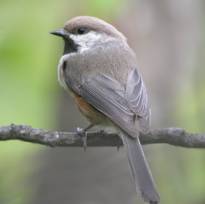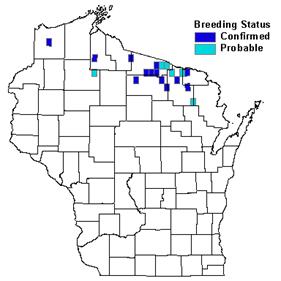Photo by Tom Prestby


Status/Protection
- Global Rank: G5 Key to global and state ranks
- State Rank: S2S3B
- WBCI Priority: SGCN, State Special Concern
Population Information
Federal BBS information can be obtained at http://www.mbr-pwrc.usgs.gov/bbs/bbs.html by clicking on Trend Estimates and selecting the species in question. All estimates are for 1966-2005.
*Note: There are important deficiencies with these data. These results may be compromised by small sample size, low relative abundance on survey route, imprecise trends, and/or missing data. Caution should be used when evaluating this trend.
- Federal Breeding Bird Survey: significant decline
- Federal Breeding Bird Survey (WI): non-significant decline*
- Federal Breeding Bird Survey (BCR 23): N/A
- Federal Breeding Bird Survey (BCR 12): non-significant decline*
- WSO Checklist Project: decreasing (1983-2007)
Life History
- Breeding Range: Alaska east across Canada to the Atlantic Coast southward into New England and a few northern states (Ficken et al. 1996).
- Breeding Habitat: Fir-Spruce, Black Spruce, Swamp Conifer-Balsam Fir, Tamarack, Open Bog-Muskeg.
- Nest: Cavity ranging from 0.1-10.5 meters above ground (Ehrlich et al. 1988, Ficken et al. 1996).
- Nesting Dates: Eggs: early May to early July (Robbins 1991).
- Foraging: Bark glean, ground glean (Ehrlich et al. 1988).
- Migrant Status: Permanent resident.
- Habitat use during Migration: N/A, although short-distance migration reported (Ficken et al. 1996).
- Arrival Dates: N/A
- Departure Dates: N/A
- Winter Range: Same as breeding range.
- Winter Habitat: Same as breeding habitat.
Habitat Selection
The Boreal Chickadee is a permanent resident of both young and mature coniferous forests, and in Wisconsin occurs in boreal forests and lowland conifer habitats dominated by black spruce and tamarack (Merkel 2006). The presence of softwood tree species may be a more important habitat variable than tree size (Warren et. al 2005) or stand age (Hagan et al. 1997). In northern Maine, Boreal Chickadees were equally abundant in medium-aged (20-60 yr old) and mature (60+ yr old) softwood stands (Hagan et al. 1997). The Boreal Chickadees is a cavity nester that will excavate its own cavity or use either natural or woodpecker-excavated cavities in dead tree stumps, snags, or dead branches. There is no evidence of preference for a particular tree species; rather softness of heartwood seems to be more important (Ficken et al. 1996).
Habitat Availability
The coniferous lowland forests used by Boreal Chickadees were widespread and relatively common historically, although they did not typically occur in large patches in Wisconsin. These forest types remain relatively common in much of their Wisconsin range today (WDNR 2005). Within the Great Lakes region, however, black spruce and other coniferous lowland forest types may have declined by as much as 15% (Snetsinger and Ventura n.d.). Wisconsin lies well outside the boreal forest biome, but harbored some “boreal-like” tracts prior to European settlement. These boreal forest stands have experienced significant alteration and loss in the past century (Mossman et al. 1990).
Population Concerns
Breeding Bird Survey data suggest significant population declines range-wide for this species (Sauer et al. 2005). Due to the rarity of the Boreal Chickadee in Wisconsin, it is not sufficiently known whether the population here is stable. This species is rarely recorded on either the Wisconsin routes of the Breeding Bird Survey or the Wisconsin Checklist Project (Temple et al. 1997, Sauer et al. 2005). During the six-year period (1995-2000) of the Wisconsin Breeding Bird Atlas, observers reported 15 breeding confirmations primarily in Florence, Forest, Oneida, and Vilas counties (Merkel 2006).
In Wisconsin loss and fragmentation of coniferous wetlands and spruce-fir forests is a concern. Road construction, agriculture, and development can alter hydrology to the detriment of these community types (WDNR 2005). In other areas of this species’ range, salvage logging during spruce budworm outbreaks allegedly reduced suitable habitat (Ficken et al. 1996).
Recommended Management
Management efforts for this species should focus on maintaining coniferous landscapes with large areas of lowland coniferous forests. Whenever feasible, utilize alternative silvicultural methods to increase boreal components in appropriate areas (e.g., allow succession of aspen to conifers) (WDNR 2005). Management practices that retain trees with nest cavities and/or retain snags and stumps in harvested areas would likely benefit this species. Conservation and management strategies for this species should be focused in the following Wisconsin ecological landscapes: North Central Forest, Northeast Sands, Northern Highland, Northwest Lowlands, and Northwest Sands (WDNR 2005). Within these landscapes, the best public lands to manage for Boreal Chickadee include Chequamegon-Nicolet National Forest and large peatlands on Douglas, Iron, Vilas, Lincoln, and Langlade County Forests.
Research Needs
More research is needed regarding the behavioral, physiological, and morphological adaptations that allow Boreal Chickadees to survive in harsh winter conditions (Ficken et al. 1996). Future monitoring efforts in Wisconsin should focus on identifying suitable habitat statewide and conducting focused surveys to determine the population status for this species. Continued research on boreal forest bird communities in general is needed to reveal more aspects of this and other species’ ecology and response to forest management in Wisconsin.
Information Sources
- Chequamegon National Forest Bird Survey (NRRI) species account: http://www.nrri.umn.edu/mnbirds/accounts/BOCHa2.htm
- Cornell Lab of Ornithology species account: http://birds.cornell.edu/BOW/BORCHI/
- National Park Service species account: http://www.nps.gov/yuch/Expanded/key_resources/birds/species_descriptions/boch_description.htm
- Nicolet National Forest Bird survey map: http://www.uwgb.edu/birds/nnf/species/BOCH.htm
- North American Breeding Bird Survey: http://www.mbr-pwrc.usgs.gov/bbs/bbs.html
- Nova Scotia species account: http://museum.gov.ns.ca/mnh/nature/nsbirds/bns0270.htm
- Boreal Songbird Initiative species account: http://www.borealbirds.org/birdguide/BD0644_species.html
- Temple S.A., J.R. Cary, and R. Rolley. 1997. Wisconsin Birds: A Seasonal and Geographical Guide. Wisconsin Society of Ornithology and Wisconsin Department of Natural Resources, Madison, WI.
- Wisconsin Breeding Bird Atlas: http://www.uwgb.edu/birds/wbba/
References
- Ehrlich, P.R., D. S. Dobkin, and D. Wheye, 1988. The Birders Handbook, A Field Guide To The Natural History of North American Birds, Simon and Schuster, Fireside. New York.
- Ficken, M.S., M.A. Mclaren and J.P. Hailman. 1996. Boreal Chickadee (Parus hudsonicus). In The Birds of North America, No.254 (A. Poole and F. Gill, eds). The Academy of Natural Sciences, Philadelphia, and The American Ornithologists’ Union Washington, D.C.
- Hagan, J.M., P.S. McKinley, A.L. Meehan, and S.L. Grove. 1997. Diversity and abundance of landbirds in a northeastern industrial forest. Journal of Wildlife Management 61(3): 718-735.
- Merkel, K. 2006. Boreal Chickadee. In Atlas of the Breeding Birds of Wisconsin. (N.J. Cutright, B.R. Harriman, and R.W. Howe, eds.) The Wisconsin Society for Ornithology, Inc. 602pp.
- Robbins, S.D. 1991. Wisconsin Birdlife, Population & Distribution Past and Present. The University of Wisconsin Press, Madison, WI.
- Sauer, J.R., J.E. Hines, and J. Fallon. 2005. The North American Breeding Bird Survey, Results and Analysis 1966 - 2005. Version 6.2.2006. USGS Patuxent Wildlife ResearchCenter, Laurel, MD.
- Temple, S. A. Cary, J. R. Rolley, R. 1997 Wisconsin Birds: A Seasonal and Geographical Guide The University of Wisconsin Press, Madison WI.
- Warren, T.L., M.G. Betts, A.W. Diamond, and G. J. Forbes. 2005. The influence of local habitat and landscape composition on cavity-nesting birds in a forested mosaic. Forest Ecology and Management 214: 331-343.
- Wisconsin Department of Natural Resources (WDNR). 2005. Wisconsin’s Strategy for Wildlife Species of Greatest Conservation Need. Madison, WI.
Contact Information
- Compiler: Ken Damro, kendamro@yahoo.com
- Editors: Kim Kreitinger, K.Kreitinger@gmail.com | Randy Hoffman, Randolph.hoffman@Wisconsin.gov
